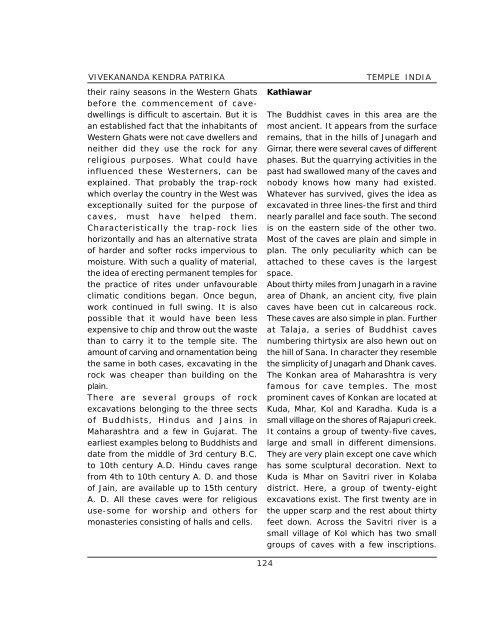Temples In India-1.pdf - Vivekananda Kendra Prakashan
Temples In India-1.pdf - Vivekananda Kendra Prakashan
Temples In India-1.pdf - Vivekananda Kendra Prakashan
You also want an ePaper? Increase the reach of your titles
YUMPU automatically turns print PDFs into web optimized ePapers that Google loves.
VIVEKANANDA KENDRA PATRIKAtheir rainy seasons in the Western Ghatsbefore the commencement of cavedwellingsis difficult to ascertain. But it isan established fact that the inhabitants ofWestern Ghats were not cave dwellers andneither did they use the rock for anyreligious purposes. What could haveinfluenced these Westerners, can beexplained. That probably the trap-rockwhich overlay the country in the West wasexceptionally suited for the purpose ofcaves, must have helped them.Characteristically the trap-rock lieshorizontally and has an alternative strataof harder and softer rocks impervious tomoisture. With such a quality of material,the idea of erecting permanent temples forthe practice of rites under unfavourableclimatic conditions began. Once begun,work continued in full swing. It is alsopossible that it would have been lessexpensive to chip and throw out the wastethan to carry it to the temple site. Theamount of carving and ornamentation beingthe same in both cases, excavating in therock was cheaper than building on theplain.There are several groups of rockexcavations belonging to the three sectsof Buddhists, Hindus and Jains inMaharashtra and a few in Gujarat. Theearliest examples belong to Buddhists anddate from the middle of 3rd century B.C.to 10th century A.D. Hindu caves rangefrom 4th to 10th century A. D. and thoseof Jain, are available up to 15th centuryA. D. All these caves were for religioususe-some for worship and others formonasteries consisting of halls and cells.KathiawarTEMPLE INDIAThe Buddhist caves in this area are themost ancient. It appears from the surfaceremains, that in the hills of Junagarh andGirnar, there were several caves of differentphases. But the quarrying activities in thepast had swallowed many of the caves andnobody knows how many had existed.Whatever has survived, gives the idea asexcavated in three lines-the first and thirdnearly parallel and face south. The secondis on the eastern side of the other two.Most of the caves are plain and simple inplan. The only peculiarity which can beattached to these caves is the largestspace.About thirty miles from Junagarh in a ravinearea of Dhank, an ancient city, five plaincaves have been cut in calcareous rock.These caves are also simple in plan. Furtherat Talaja, a series of Buddhist cavesnumbering thirtysix are also hewn out onthe hill of Sana. <strong>In</strong> character they resemblethe simplicity of Junagarh and Dhank caves.The Konkan area of Maharashtra is veryfamous for cave temples. The mostprominent caves of Konkan are located atKuda, Mhar, Kol and Karadha. Kuda is asmall village on the shores of Rajapuri creek.It contains a group of twenty-five caves,large and small in different dimensions.They are very plain except one cave whichhas some sculptural decoration. Next toKuda is Mhar on Savitri river in Kolabadistrict. Here, a group of twenty-eightexcavations exist. The first twenty are inthe upper scarp and the rest about thirtyfeet down. Across the Savitri river is asmall village of Kol which has two smallgroups of caves with a few inscriptions.124
















